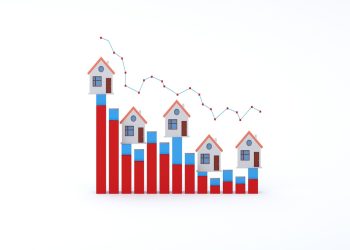Housing starts decreased from October to November, according to the U.S. Census Bureau’s latest monthly report on new construction. Within that overall decline, though, the number of single-family home starts increased month-over-month.
In November, privately owned housing starts reported a seasonally adjusted annual rate of 1,289,000, a 1.8% drop from the revised October rate of 1,312,000. There was an even larger 14.6% drop year-over-year, as housing starts were reported at 1,510,000 in November 2023.
Single-family housing starts in November 2024 were 1,011,000, a 6.4% increase over the revised October figure of 950,000. Multifamily construction, though, experienced a 24.6% downturn; starts of units in properties with more than five units dropped to 264,000.
In response to the housing starts report, National Association of Home Builders (NAHB) Chief Economist Robert Dietz projected a modest uptick for construction of all unit types at the beginning of 2025.
“NAHB is forecasting single-family starts to post a slight increase in 2025 as the financing conditions for builders improve modestly. The significant decline for apartment construction is forecasted to end, with that market stabilizing during the second half of next year,” said Dietz in an NAHB release.
While starts declined, building permits increased. Authorized building permits were reported at 1,505,000 in November 2024; this is 6.1% higher than the revised October rate, but slightly lower than the reported rate of permits in November 2023 (1,508,000). Single-family permits also posted a slight increase from October to November 2024 (971,000 to 972,000), and multifamily unit authorizations were at 481,000.
NAHB Chairman Carl Harris said in the aforementioned NAHB release that “(w)hile single-family starts were up in November, single-family permits were flat as builders face mixed market conditions that include an election result that promises a focus on regulatory relief, but ongoing elevated mortgage rates.”
High mortgage rates were cited as an anchor dragging construction down in the previous housing starts report. At the time, CoreLogic Chief Economist Dr. Selma Hepp said that “high mortgage rates (will) continue to hinder recovery,” resulting in an “anemic” housing market this winter.
Mortgage rates have been dropping since the start of December 2024, which experts such as Freddie Mac Chief Economist Sam Khater have said is boosting homebuyer demand. The Federal Reserve is expected to cut interest rates at its December meeting, which could keep mortgage rates falling even lower and boost demand yet again.
It is not only buyers who are eyeing the housing market. The latest report on homebuilder confidence suggested a fairly optimistic outlook, owing in part to expected regulatory relief from the incoming administration next year. However, there are also concerns (expressed by NAHB CEO Jim Tobin) that proposed policies such as deportation could reduce available labor in the construction sector.
Bright MLS Chief Economist Dr. Lisa Sturtevant said in a statement that a small drop year-over-year in single-family starts is notable, as a leading indicator for overall homebuilding.
She also agreed that builder optimism around planned policies of the incoming Trump administration might need to be balanced around the holistic effects of all Trump’s plans.
“President-elect Donald Trump has promised to reduce regulation to make it easier to build new housing, which would be a positive for new housing starts in the year ahead. However, other initiatives proposed by the President-elect—namely tariffs and deportation policies—could have the opposite effect, making it more difficult to deliver new housing,” she said.
Regional breakdown
At a seasonally adjusted rate, the Northeast and the South experienced positive monthly growth in combined single and multifamily housing starts. From October to November, the Northeast posted a 10.6% increase, while the South experienced a 10.2% increase. Combined starts in the West, though, declined monthly by 11.9% and 28.2% in the Midwest.
Year-over-year, every region declined in the number of combined starts. From November 2023 to November 2024, Northeast starts declined by 10.9%, in the Midwest by 22.2%, in the South by 11.1% and in the West by 19.7%.
For the full report, click here.












